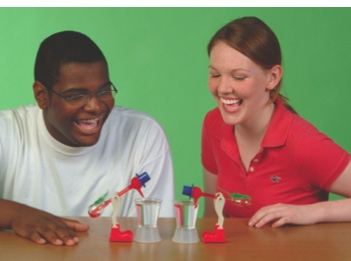This student reading is courtesy of ChemMatters, the ACS quarterly magazine division that explores chemistry behind everyday life. Learn more about ChemMatters, view free online content, or subscribe at acs.org/chemmatters.
The drinking bird is a mesmerizing little science toy that has fascinated young and old for more than 50 years. It is also known as the happy bird, the dippy bird, the happy dippy bird, and other variations on this same theme. It looks like a bird and will bob up and down as it appears to drink out of a glass of water. As long as it can reach the water, it will bob up and down indefinitely. The drinking bird consists of two elongated glass bulbs that are connected by a straight glass tube extending well into the interior of the bottom bulb.
How Does It Work?

The only way any substance can pass between the two bulbs is through this narrow glass tube. The top bulb is covered with a porous felt like material that also makes up the beak.On top of the head is a plastic top hat, which is only for decoration. Taped to the bottom chamber are tail feathers, which help it to maintain balance. The whole thing is suspended from plastic legs, with a horizontal piece of metal that acts as a pivot, allowing it to bob up and down. Inside, the drinking bird is a highly volatile liquid known as methylene chloride (CH2Cl2).
Since methylene chloride is colorless, coloring must be added to enhance the visual effect. This liquid is also highly volatile, meaning it evaporates rapidly due to weak intermolecular bonds in the liquid state. Its boiling point is 39.7 °C (103.5 °F), and its vapor pressure at room temperature is 46 kilopascals (compared to only 3 kPa for water). Methylene chloride is somewhat toxic, so if a drinking bird breaks, care must be exercised in cleaning it up. Methylene chloride is commonly used as an industrial cleaner, degreaser, and paint remover. After the methylene chloride is added by the manufacturer, most of the remaining air is then vacuumed out.
Because a near vacuum now exists within the bird, the highly volatile liquid readily evaporates until the space above the liquid is saturated with vapor. At this point, a dynamic equilibrium is established within the bird between the liquid and the vapor above it. Once equilibrium is established, anytime a molecule evaporates, another molecule will condense, resulting in an overall constant amount of vapor within the bird as long as the temperature stays constant. To activate the drinking bird, his head is dipped into a glass of water, and he is then set upright in such a position that when he tips his beak, he will be able to reach into the glass of water. Once the head is wet, a strange thing immediately begins to happen. Like magic, the fluid begins to rise upward into the head, until his head fills with liquid. The head then becomes top heavy as the center of gravity of the bird is raised. The bird then topples over, takes another drink. As the bird tips over, the liquid flows back to the bottom bulb, restoring the low center of gravity. The bird resumes its upright position, beginning the whole process all over again.
To understand what makes the fluid rise within the bird, think about what happens whenever your own head gets wet. As long as the relative humidity is not 100%, the water will immediately begin to evaporate. And evaporation always causes cooling, because it is an endothermic process. That’s why you sweat when you get hot; it’s not the sweating itself that cools you, but rather the evaporation of the sweat from your body. Any phase change that requires bond breaking will be endothermic, because energy is required to break bonds. This energy is drawn from the surroundings, thereby causing the temperature of the surroundings to decrease. Because water evaporates from the head of the bird, the head immediately begins to cool. This is the most crucial point in understanding how the drinking bird works.
Cooler Heads Prevail
If you could cool the head another way, the drinking bird would work just the same. When the head begins to cool, some of the vapor within the head will condense into tiny droplets of liquid. A similar process occurs at night when water vapor condenses out of the air as it cools, forming dew on the ground. Because some of the vapor condenses within the top chamber of the bird, there is now less vapor pressure in the top bulb. Less vapor means less pressure. But the vapor pressure within the bottom bulb has not changed. Because the vapor pressure in the bottom bulb is now greater than the pressure in the top bulb, the liquid is forced upward into the top chamber. (Don’t say the liquid is sucked up into the top chamber—science never sucks!) Once the bird tips over, vapor from the bottom travels to the top until the pressure in both spheres equalizes and the bird begins the process all over again.

To understand how a pressure differential causes fluid within the bird to rise, consider what happens when you use an ordinary drinking straw. When you suck fluid up into the straw, you create a region of reduced pressure within the straw. Because outside air pressure is greater, it pushes downward on the surface of the fluid, forcing it upward.
Drinking Birds in the Wild
Not only is the drinking bird educational, but it can also provide hours of entertainment. Many science museums feature displays of drinking birds. No science classroom would be complete without one. The amazing drinking bird has even appeared in a 1995 episode of The Simpsons, where Homer positions a drinking bird in front of his keyboard to help monitor the controls at the Springfield nuclear power plant. The artist Daniel Reynolds spent a small fortune and several years developing an art exhibit comprising a whole flock of giant 6½ feet tall drinking birds, each weighing 3,000 times more than an original drinking bird. They had to be made with a special vacuum attachment in order to work properly.
There are many variations on the drinking bird. They come in a variety of styles and sizes. There is even a drinking giraffe! The very popular, but falsely named “hand-boiler” is nothing more than a drinking bird that is stripped down to the bare essentials. It works either by cooling the top or warming the bottom.
The next time you need a unique gift for the person who has everything, consider a drinking bird. A quick search on the Internet will reveal a plethora of sources. They especially make great gifts for science teachers!
Download Article
More Experiments You Can Perform With the Drinking Bird
- Place a gallon-size freezer bag over an operational drinking bird. He will almost immediately stop drinking. Can you explain why?
- Have a drinking bird “drink” hot water and then ice-cold water. Which will make the bird drink faster?
- Have the bird “drink” a liquid with a higher evaporation rate than water, such as rubbing alcohol. Does the drinking bird drink faster?
- Instead of cooling the head, heat the body, either with your hand or a heat lamp. Does the drinking bird work?
- If you have a spare drinking bird that you don’t mind disfiguring, paint the top bulb silver and the bottom bulb black. Place in a sunny windowsill and watch it bob up and down! No water required.

